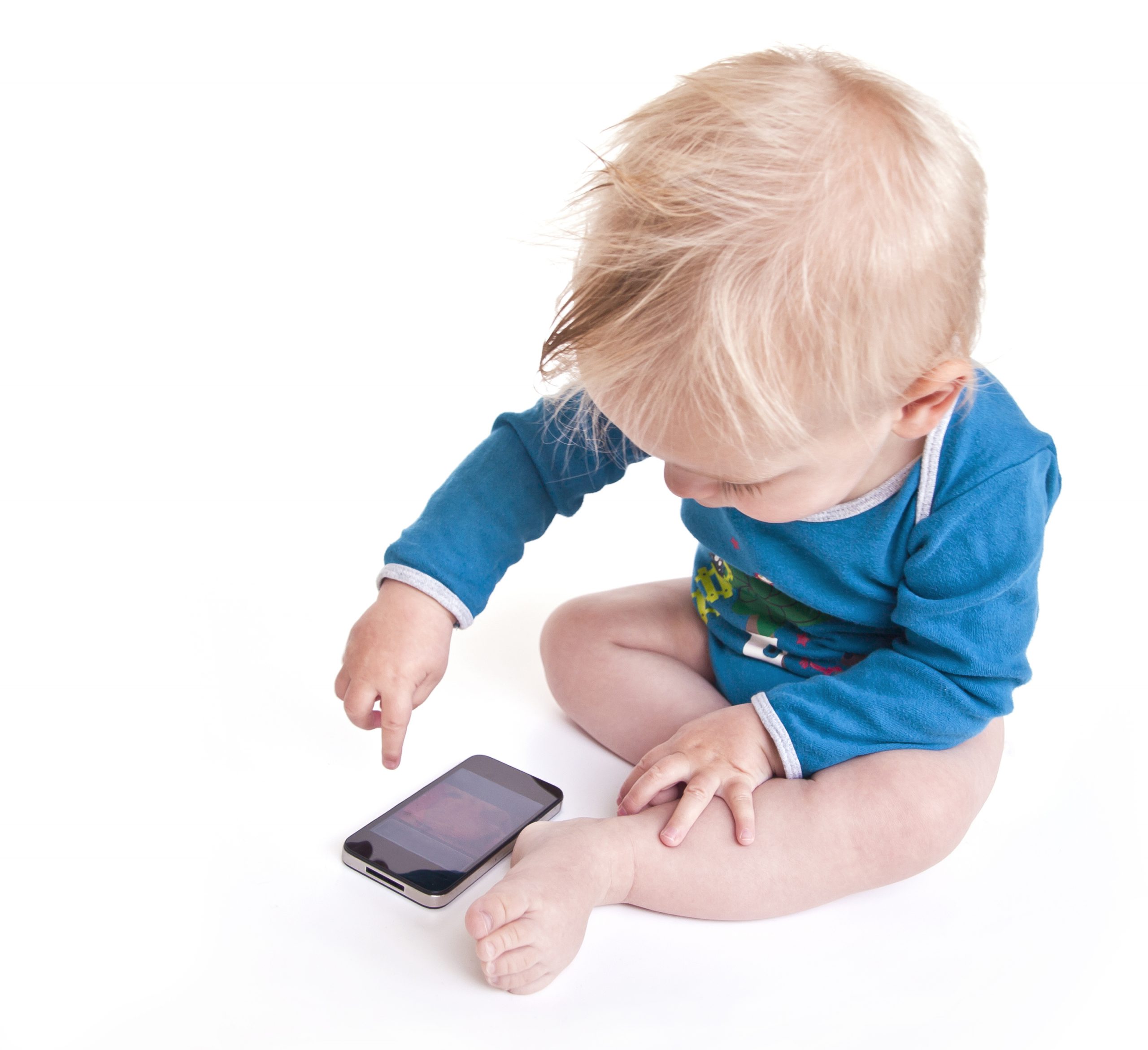Written By: Tracey Tasker, MBA, MA, CCC/SLP
 Raise your hand if this sounds familiar to you. Every week when you arrive at a family’s home the TV is always on, or your client is on mom’s phone. Mom turns off the TV or takes the phone away and you spend the first 10 minutes of your session trying to calm your client down. I’m guessing that most of you have your hand raised at this point. That’s because children are being given screen time at a younger age and for longer durations. A national poll found that 36% of children under 2 were given tablets to use and 38% were being given smartphones. Unfortunately, Covid-19 made a poor situation worse; in 2020 the number of children under four who spent 4 or more hours daily using electronic devices doubled.
Raise your hand if this sounds familiar to you. Every week when you arrive at a family’s home the TV is always on, or your client is on mom’s phone. Mom turns off the TV or takes the phone away and you spend the first 10 minutes of your session trying to calm your client down. I’m guessing that most of you have your hand raised at this point. That’s because children are being given screen time at a younger age and for longer durations. A national poll found that 36% of children under 2 were given tablets to use and 38% were being given smartphones. Unfortunately, Covid-19 made a poor situation worse; in 2020 the number of children under four who spent 4 or more hours daily using electronic devices doubled.
What’s the big deal about young children and screens?
The big deal is that we are already starting to see declines in cognitive development for young children who are spending too much time on devices. Research found that the more time per week that children spent on screens between two and three years old the poorer their performance on behavioral, cognitive, and social development at 3 years old. Other problems from too much screen time include poor sleep, vision problems, and obesity. Research has also found that increased use of screens was also associated with less efficient and organized brain development in the area of the brain that supports language, executive functioning, and literacy skills.
The timing of when we introduce screens is important
The most important period of brain development occurs before we turn 3 years old. We call this period of brain development the “sensitive period” because of the rapid growth and “plasticity” of the brain. Plasticity refers to the brain’s ability to change and restructure based on input. The most important input to develop language during the sensitive period is reciprocity, which is the back-and-forth communication between a parent and a child. Screens interrupt this reciprocity and research has found that an increase of just 30 minutes per day in mobile media device use is associated with a 2.3 times increased risk of an expressive language delay.
Young children don’t learn from videos – they learn from people
Gross motor skills develop before other skills, therefore children need to move and use multisensory input to holistically learn about the world. When children learn words from a two-dimensional screen, they experience what is called a “video transfer deficit.” A transfer deficit is the inability to take what they see on a screen and “transfer” it to the real world. For example, they may learn the word “apple” on a video app but when they see a real apple they don’t recognize it as the same thing they saw on the screen.
Adults need to set a good example
Researchers have come up with the term “technoference” which refers to technology interfering in relationships. Parent surveys have found that technology interrupts parent-child interactions and that parents have difficulty switching their attention between devices and their children. Surveys with children as young as 5 found that their parents spend too much time on their cell phones and are distracted during conversations. Research has found that parent cell phone use is associated with less talking, less responsiveness, and sometimes actually harsher parental responses to children. In addition to cell phone use disrupting language acquisition, background TV is also found to have negative effects on language. Like the negative effects of cell phones, research has found that when TV is on in the background it decreases time spent interacting with young children and decreases the number of words children hear from an adult. This lack of interaction resulted in poorer vocabulary scores and lower levels of language development.

Cell phones are the new pacifiers
Screen time – whether too early and/or too much, can also affect social-emotional development. Research has found that toddlers with social-emotional delays are more likely to be given a mobile device to calm them down. The problem is that often when we give these children a mobile device to calm them down, we make a bad situation worse. Screen time creates a dopamine boost for children and when that device is taken away it creates irritability. In addition, the more we give that device to children the more it becomes a habit and the harder it will be to break that habit. Research has found that the more we give children devices to distract them or reward them, the more children will ask for the device more often and become upset more often when it is refused, creating a vicious cycle.
Parents aren’t always aware of screen time guidelines and risks
One thing that we can do as early interventionists is educate parents. Clinicians are often leery about broaching the topic because they feel that it will be seen as parent “shaming.” Unfortunately, research shows that parents aren’t even aware that there are recommendations by the AAP (American Academy of Pediatrics) about screen time.
I hope that you will consider joining me on March 23 for my Live Webinar, Screen Time and the Impact on the Development of Young Children, where I will review the research and give you tips on how to talk to parents about this important topic.
Visit summit-education.com for more information.
References:
Christakis, D. A., Gilkerson, J., Richards, J. A., Zimmerman, F. J., Garrison, M. M., Xu, D., Gray, S., & Yapanel, U. (2009). Audible television and decreased adult words, infant vocalizations, and conversational turns: a population-based study: A population-based study. Archives of Pediatrics & Adolescent Medicine, 163(6), 554–558. https://doi.org/10.1001/archpediatrics.2009.61
Deoni, S. (2022). Impact of the COVID-19 pandemic environment on early child brain and cognitive development. Biological Psychiatry, 91(9), S26. https://doi.org/10.1016/j.biopsych.2022.02.082
Hutton, J. S., Dudley, J., Horowitz-Kraus, T., DeWitt, T., & Holland, S. K. (2020). Associations between screen-based media use and brain white matter integrity in preschool-aged children. JAMA Pediatrics, 174(1), e193869. https://doi.org/10.1001/jamapediatrics.2019.3869
Lammers, S. M., Woods, R. J., Brotherson, S. E., Deal, J. E., & Platt, C. A. (2022). Explaining adherence to American Academy of Pediatrics screen time recommendations with caregiver awareness and parental motivation factors: Mixed methods study. JMIR Pediatrics and Parenting, 5(2), e29102. https://doi.org/10.2196/29102
Madigan, S., Browne, D., Racine, N., Mori, C., & Tough, S. (2019). Association between screen time and children’s performance on a developmental screening test. JAMA Pediatrics, 173(3), 244–250. https://doi.org/10.1001/jamapediatrics.2018.5056
McDaniel, B. T. (2019). Parent distraction with phones, reasons for use, and impacts on parenting and child outcomes: A review of the emerging research. Human Behavior and Emerging Technologies, 1(2), 72–80. https://doi.org/10.1002/hbe2.139
Petrosyan, A. (2022). Children and teens from the United States who spent more than four hours daily using electronics devices before and during the coronavirus pandemic according to parents as of June 2020, by age group [Data set]. In U.S. kids & teens with 4hrs+ screen time before and during COVID-19 pandemic 2020. https://www.statista.com/statistics/1189204/us-teens-children-screen-time-daily-coronavirus-before-during/
Pew Research Center. (2020). Parenting Children in the Age of Screens. https://www.pewresearch.org/internet/2020/07/28/parenting-children-in-the-age-of-screens/
Radesky, J. S., Kistin, C. J., Zuckerman, B., Nitzberg, K., Gross, J., Kaplan-Sanoff, M., Augustyn, M., & Silverstein, M. (2014). Patterns of mobile device use by caregivers and children during meals in fast food restaurants. Pediatrics, 133(4), e843-9. https://doi.org/10.1542/peds.2013-3703
Smartphone Use in the Daily Interactions between Parents and Young Children. (2015, March). https://www.csustan.edu/cdev/research
Van den Heuvel, M., Ma, J., Borkhoff, C. M., Koroshegyi, C., Dai, D. W. H., Parkin, P. C., Maguire, J. L., Birken, C. S., & TARGet Kids! Collaboration. (2019). Mobile media device use is associated with expressive language delay in 18-month-old children. Journal of Developmental and Behavioral Pediatrics: JDBP, 40(2), 99–104. https://doi.org/10.1097/DBP.0000000000000630
